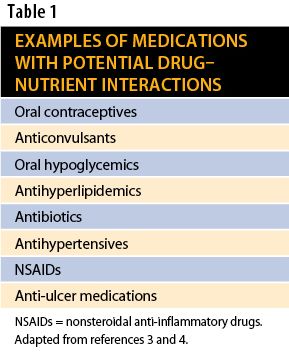Boosting Nutritional Health
New multivitamin and multimineral supplements are available to address very specific nutritional needs.

A number of multivitamin/multimineral supplements have been developed to meet the needs of specific patient populations. For example, there are gender- specific multivitamin supplements, age-specific formulations, and supplements that address the nutritional needs of adolescents, adults in their reproductive years, and women going through menopause. Multivitamin supplements can help improve cardiovascular health, promote energy, and provide a boost for those who engage in sports or thoseon weight loss plans. Many of the formulations are available in tablet form, as well as chewable, liquid, and gummy forms.
Although the majority of patients attain their nutritional goals through food and drink, many elect to use a multivitamin/ multimineral supplement to improve their overall dietary health. Pharmacists are in a pivotal position to guide patients in choosing an appropriate supplement, and identify those who are at risk for drug—micronutrient interactions (Table 1). Patients with severe nutritional deficiencies should always be referred to their primary health care provider for further evaluation.
Multivitamin/Multimineral Supplements
Some of the newest multivitamin/multimineral supplements on the market include One A Day VitaCraves Gummies Immunity Support (Bayer Consumer Health) and One A Day Menopause Formula, which is formulated with soy isoflavones to help women deal with menopause- related changes such as hot flashes and mood swings.1
One A Day Men’s Pro Edge, a formulation targeted toward physically active men, contains antioxidants, magnesium to support healthy muscle function, and B vitamins to help convert food to fuel.1 Another new product from Bayer Consumer Health is One A Day Women’s plus Healthy Skin, which contains FloraGLO Lutein to support skin smoothness, moisture, and elasticity.1 Some of these formulations also contain ginkgo biloba for improved memory and concentration.

Providing Guidance
Prior to recommending any multivitamin/ multimineral supplement to patients (Table 2), pharmacists should assess the patient’s medical history and medication profile to
check for potential drug—micronutrient interactions or contraindications, as there are several medications that may cause interactions. For example, patients taking phenytoin may develop a folic acid or vitamin D deficiency, whereas those taking antidepressants may have lower levels of vitamins B6, B12, and D.2-4 Sulfonylureas and lithium may impair the uptake or release of iodine by the thyroid, and oral contraceptives may cause reduced plasma zinc levels, increased copper levels, and folic acid depletion.3,4 Metformin and anti-ulcer agents may decrease absorption of vitamin B12 and folic acid.2-4
Patients should be reminded that these supplements are designed to prevent nutritional deficiencies and maintain nutrient levels, and are not intended for the self-treatment of vitamin deficiencies.3,4 Patients with vitamin deficiencies should be referred for further medical evaluation when warranted. To help avoid therapeutic duplications and decrease the incidence of potential toxicities, pharmacists should also determine whether a patient is currently taking any other nutritional supplements before making any recommendations.
Patients should also be reminded to take supplements as directed, adhere to a nutritious diet, and maintain an active lifestyle to ensure optimal health. PT
Ms. Terrie is a clinical pharmacy writer based in Haymarket, Virginia.

